

Socioeconomic status influences influenza hospitalization rates. Socioeconomic status, particularly living in poverty, increased the rate of influenza hospitalizations, according to surveillance data from Tennessee.
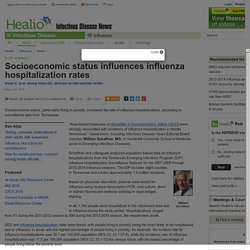
“Area-based measures of disparities in [socioeconomic status (SES)] were strongly associated with incidence of influenza hospitalization in Middle Tennessee,” researchers, including Infectious Disease News Editorial Board member William Schaffner, MD, of Vanderbilt University School of Medicine, wrote in Emerging Infectious Diseases. William Schaffner Schaffner and colleagues analyzed population-based data on influenza hospitalizations from the Tennessee Emerging Infections Program (EIP) Influenza Hospitalization Surveillance Network for the 2007-2008 through 2013-2014 influenza seasons. The EIP includes eight counties in Tennessee and covers approximately 1.5 million residents. In all, 1,743 people were hospitalized in the catchment area due to influenza during the study period. Eurosurveillance. Eurosurveillance - View Article. Avian influenza A(H7N9) virus re-emerged in China in December 2013, after a decrease in the number of new cases during the preceding six months.
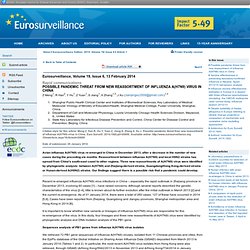
Reassortment between influenza A(H7N9) and local H9N2 strains has spread from China's south-east coast to other regions. China vuelve a dar la alarma por la gripe aviar. Se había dejado de hablar de ella, pero la gripe aviar no se ha marchado nunca.

De hecho, en China reaparece con fuerza y con nuevas cepas del virus. A la H5N1, que provocó el temor hace una década, se han sumado la H7N9, detectada en febrero del año pasado y que provoca actualmente el mayor número de infecciones; y la H10N8. WHO says new coronavirus may be passed person to person. 12 May 2013Last updated at 14:46 ET The World Health Organisation says it is closely monitoring the novel coronavirus The World Health Organization says it appears likely that the novel coronavirus (NCoV) can be passed between people in close contact.
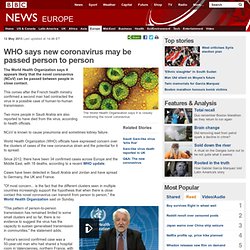
This comes after the French health ministry confirmed a second man had contracted the virus in a possible case of human-to-human transmission. Two more people in Saudi Arabia are also reported to have died from the virus, according to health officials. NCoV is known to cause pneumonia and sometimes kidney failure. World Health Organization (WHO) officials have expressed concern over the clusters of cases of the new coronavirus strain and the potential for it to spread. Since 2012, there have been 34 confirmed cases across Europe and the Middle East, with 18 deaths, according to a recent WHO update.
Cases have been detected in Saudi Arabia and Jordan and have spread to Germany, the UK and France. Continue reading the main story. Transcript of media briefing by Dr Michael O'Leary, WHO Representative in China. DR MICHAEL O’LEARY: Good afternoon, and thank you for coming.
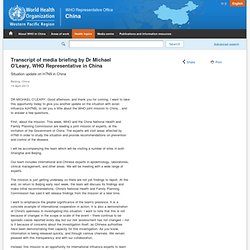
I want to take this opportunity today to give you another update on the situation with avian influenza A(H7N9), to tell you a little about the WHO joint mission to China, , and to answer a few questions. First, about the mission. This week, WHO and the China National Health and Family Planning Commission are leading a joint mission of experts, at the invitation of the Government of China.
The experts will visit areas affected by H7N9 in order to study the situation and provide recommendations on prevention and control of the disease. I will be accompanying the team which will be visiting a number of sites in both Shanghai and Beijing. Our team includes international and Chinese experts in epidemiology, laboratories, clinical management, and other areas.
The mission is just getting underway so there are not yet findings to report. ProMED-mail. View printable version Share this post: Published Date: 2013-04-18 16:55:10Subject: PRO/AH/EDR> Avian influenza (40): (China) zoonotic LPAI H7N9, source sought Archive Number: 20130418.1655718 AVIAN INFLUENZA (40): (CHINA) ZOONOTIC LPAI H7N9, SOURCE SOUGHT***************************************************************A ProMED-mail is a program of theInternational Society for Infectious [1]Date: Thu 18 Apr 2013Source: Winnipeg Free Press [edited] As China struggles to find the source of the new flu infecting a growing number of its citizens, tests of the usual animal suspects are mostly coming back negative.
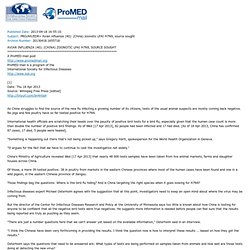
No pigs and few poultry have so far tested positive for H7N9. International health officials are scratching their heads over the paucity of positive bird tests for a bird flu, especially given that the human case count is more than double the number of positive bird findings. "It argues for the fact that we have to continue to cast the investigation net widely. " In U.S., flu vaccine worked in just over half of those who got it. ProMED-mail. View printable version Share this post: Published Date: 2012-09-11 22:10:12Subject: PRO/AH/EDR> Influenza (84): Canada, pandemic H1N1 vaccination model Archive Number: 20120911.1290334 INFLUENZA (84): CANADA, PANDEMIC H1N1 VACCINATION MODEL*******************************************************A ProMED-mail is a program of theInternational Society for Infectious Date: Sun 9 Sep 2012Source: CTV News, The Canadian Press report [edited] Flu shot issue may not be 'Canadian problem' after all: study-------------------------------------------------------------A strange vaccine-related phenomenon spotted at the start of the 2009 flu pandemic may well have been real, a new study suggests.
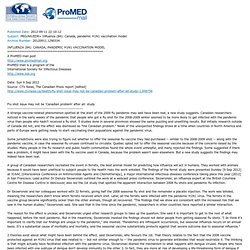
Some jurisdictions were also trying to figure out whether to offer the seasonal flu vaccine they had purchased -- similar to the 2008-2009 shot -- along with the pandemic vaccine, in case the seasonal flu viruses continued to circulate.